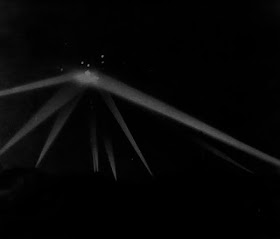The days preceding and following what is coyly referred to as "The Roswell Incident" the military (apparently led in part by Schulgen) were covertly investigating the many reports of odd things in the skies. The FBI, because of the real threat of Soviet covert operations, was equally curious. Since no one seemed to know what they were....the curiosity intensified.
Schulgen, already involved in some top secret work related to some special projects, was selected to follow up on an idea. The FBI had the "legs" in the form of field investigators and the military did not have a wide scale investigative element capable at the time of the type of vetting required to sort the wheat from the chaff of all those reports. Could perhaps the FBI lend the military a hand? J. Edgar Hoover and his directors had been burned before through military stonewalling...he was therefore cautious and agreed on specific grounds.
a-memo-FBI-hoover-handwriting-good-above.jpg (1438×1833) (luforu.org)

Since a little earlier in the month there had been a deliberate hoax in Shreveport, Louisiana, many assume that is the case referred to by JEH. Although the "La" was a traditional abbreviation for Louisiana in the time, might it be something else? JEH was inconsistent in many of his shortcuts in his notes. For one thing, the FBI did, apparently, get information about the Shreveport "disc" - made as a practical joker there. Similarly, other similar hoaxes had been accessible to them as well from numerous records.
Could it be that the "La" referred not to a recent case but from nearly six years previously? The Battle of Los Angeles on 25 February 1942.
The event was classified as "war nerves": that did not say much about the 12,000 air raid wardens, the 37th Coast Artillery Brigade antiaircraft batteries, and the 4th Interceptor Command, as well as local law enforcement and many others. Over 1,430 rounds of antiaircraft shells were expended, including 12 8-pound shells. Reports from the field by Herald Express newspaper staff indicated they had eyewitnesses among the reporters of shells hitting the "object" directly - but nothing was shot down. The image below shows the familiar image from the newspaper. Searchlights are focused on the strong light mass in the center. Above it shells are exploding. Darkened, the image highlights the sense of a "something" in the core heart of the beams.
In 1974 under provisions of a FOIA request a 1942 memo came to light. Written by George C. Marshall, Chief of Staff, and sent to President Roosevelt on 26 February 1942, there were some fascinating facts...
Unidentified airplanes were "probably" fired upon over Los Angeles (LA), This statement verifies the number of rounds fired and by what Brigade,
As many as "fifteen" of those unidentified (they were not Army or Navy planes) may have been involved flying at various speeds (slow to 200 mph) and altitudes of 9,000 to 10,000 feet.
*No bombs were dropped.
*No causalities among US troops
*No planes were shot down
*No American Army or Navy planes were in action
A note on the speed estimate indicates that the report may have ignored an eyewitness driving near Douglas Aircraft Company near Pasadena and ordered to park and douse his lights by an Air Raid Warden. He observed "bright red spots of lights" low on the horizon to the south - moving in an odd manner. The lights were zig-zagging low to the ground at about 10,000 feet. The witness, Paul T Collins, indicated he could see different batteries firing and the red objects caught in the process - moving in and around the bursting shells at incredible speed. He estimates about "five miles per second." He noted from the position he and others were, they could not see the "enormous UFO" because it was probably below their horizon, but they did see the fast paced, and mobile, red lights objects.
"Prior to the release of the Marshall memorandum, the Department of Defense state that they had no record of the event." The contradictions of timelines, descriptions, the insulting classification of serious and trained military and civilians as frightened and trigger-happy causes one to consider that there was a coverup involved.... (See Timothy Good's ABOVE TOP SECRET for more of the early events of the modern era).



No comments:
Post a Comment